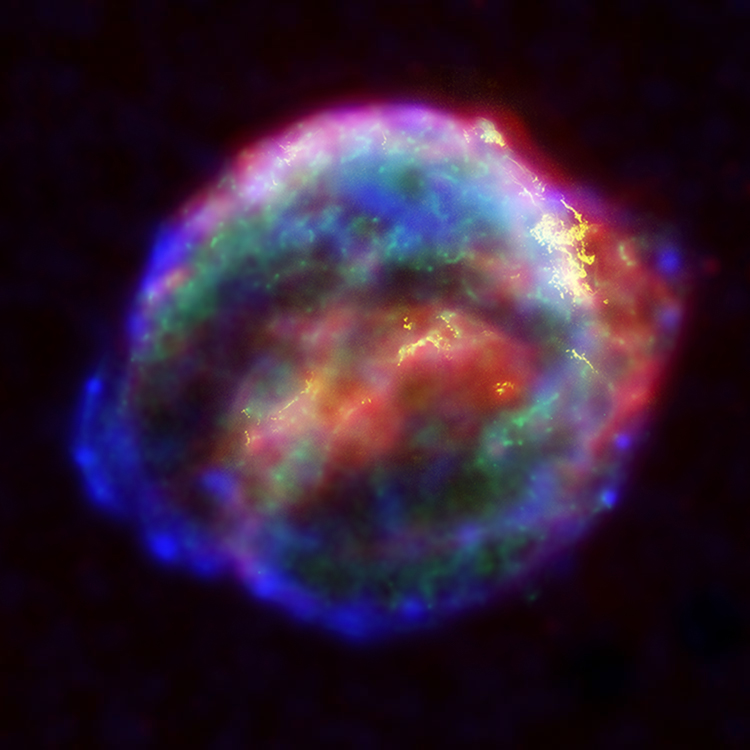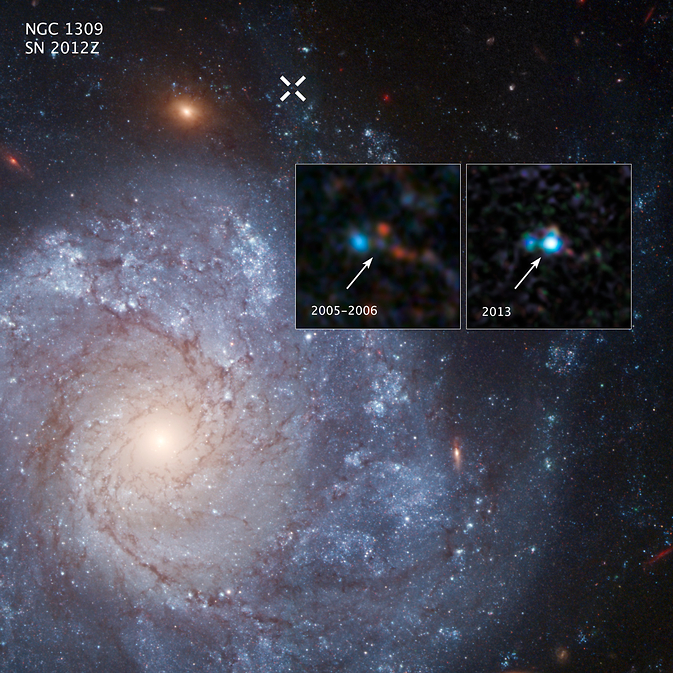How do supernovae form?
During its life on the main sequence, the star remains in
And these two processes regulate each other.If gravity wins, the star begins to shrink, but because of this, the pressure, density, and hence temperature rises in the core, and more energy begins to be released and gravity is again balanced.
This also works in the opposite direction, if strongerthere is pressure coming from the center, the star expands, the pressure decreases and then energy is generated in the center and the balance is restored again. Through this mechanism, stars are in equilibrium throughout their life on the main sequence.
When our sun comes to an end,and in its core, hydrogen will begin to run out, from which helium is synthesized, when the temperature necessary for the combustion of helium reaches 100 million degrees in the core, carbon will begin to be synthesized. But our Sun does not have enough mass to start the next fusion cycle, and ultimately a planetary nebula and a white dwarf are left.
 Kepler supernova remnant
Kepler supernova remnant
However, the stars are more massive than our Sun, having passed thosethe same stages, due to stronger gravity, do not stop at carbon, but continue to further synthesize increasingly heavier elements, such as neon, oxygen, silicon. And each next phase is much shorter than the previous one.
If hydrogen is burned, a massive star canmillions of years, the silicon phase can last only weeks. During all these phases, it still maintains equilibrium and resists gravity due to the released energy. But only as long as thermonuclear reactions do not reach iron.
Iron is already absorbed during synthesisenergy, balance is violated, gravity wins and the core collapses in a second. In this case, a huge amount of energy is released and a supernova explosion occurs. As a result, depending on the initial mass of the star, either a neutron star or a black hole remains. This is a simplified description of only one of the mechanisms of nuclear collapse.
What are zombie stars?
The zombie star is a hypothetical supernovaType Iax, or type Iax, which after exploding leaves behind a remnant star rather than completely dissipating the stellar mass. Type Iax supernovae are similar to Type Ia supernovae, but have a slower ejection velocity and do not glow as brightly.
- What happens to them?
Type Ia supernovae explode from binary systems,which consist of at least one white dwarf—a tiny, super-dense star that has stopped undergoing nuclear fusion. White dwarfs are “dead”, but in this form they cannot remain in a binary system.
They can return to life, albeit for a short time, in a giant explosion along with a supernova, sucking life from their companion star or by merging with it.
In most cases, supernovae are actuallyrepresent the final phase of a star's life, when they literally explode and are completely destroyed. However, scientists at NASA believe that supernovae may leave behind part of a dying dwarf star.
- First type of explosion
A main sequence star remains stable because gravity is counteracted by gas pressure and radiation produced by thermonuclear reactions in the core.
But since white dwarfs lack this, herethere is already another mechanism opposing the gravitational pull of the star and this is the pressure of the degenerate electron gas. But now we will not analyze this process associated with quantum effects.
And this mechanism also has a limit, a mass limit, after which a white dwarf cannot exist stably. This is the Chandrasekhar limit, estimated at about 1.4 solar masses.
A white dwarf can explode as a new one, not a supernova, but a new one. Gaining mass from the companion star, a layer of mostly hydrogen forms on the surface.
If the mass of the object does not approach the limitChandrasekhar at a certain point in this layer, thermonuclear reactions are launched. They start happening very quickly, like an explosion. A large amount of energy is released and the external accumulated layer is discarded, and the white dwarf remains, so a new one flares up.
And this name appeared because forobserver on Earth, a very bright star appears in the sky and it may be the third brightest object after the Sun and the Moon. In a place where a star was not visible before, a new one was born, and then the brightness quickly decreases. And a similar process with one white dwarf can be repeated many times.
If, on the contrary, a white dwarf, gaining mass,overcomes the Chandrasekhar limit, the pressure of the degenerate electron gas can no longer withstand gravity. Under its influence, the white dwarf collapses and becomes an even denser and more compact object, a neutron star.
 Supernova remnant RCW 103 with neutron star 1E 161348-5055 in the center
Supernova remnant RCW 103 with neutron star 1E 161348-5055 in the center
- Second type of explosion
Another option is just a supernova explosiontype 1a. Scientists are still debating the details of this process, but in general terms it looks like this. When, as the white dwarf accumulates mass, it approaches the Chandrasekhar limit, the temperature in the white dwarf increases so much that thermonuclear reactions of carbon combustion are triggered.
These reactions are very fast and explosive,a supernova explosion occurs. Type Ia supernovae are very important and are actively studied also because they can be used to measure distances in space as so-called standard candles.
After all, an object always explodes with approximately the same mass, and you can calculate the energy of the explosion and, roughly speaking, the brightness of the object.
- When did you find out about them?
For the first time about the possibility of zombie stars appearingAstronomers started talking when they observed a dim blue star feeding its energy to a larger companion star. This process ultimately resulted in a relatively small supernova, classified as Type Iax.
It is not very bright and does not exude as much stellar mass as class Iax supernovae do. At the moment, this is the only known process leading to the explosion of white dwarfs.

Typically stars that explode at the endtheir life cycle, massive and have relatively short transient cycles. White dwarfs, in turn, are colder, live longer, and usually do not explode. Instead, they scatter their mass, creating a planetary nebula.
- How many were found?
NASA experts say they have already discoveredabout 30 supernovae of the Type Iax subclass, leaving behind the surviving white dwarfs. However, more research and observation is required to confirm their existence.
Zombie Star Representatives
- iPTF14hls
In 2017, astronomers announced the existence of a supernova iPTF14hls, which exploded several times over a period of more than 50 years. This completely refutes existing knowledge about the end of a star's life.
An ordinary supernova rises to its maximumbrightness and disappears in about 100 days. Supernova iPTF14hls brightened and dimmed at least five times over two years. Astronomers sifted through archived data and were amazed to find evidence of it exploding in 1954 at the same spot in the sky.
Apparently iPTF14hls somehow survived the earlier explosion and exploded again in 2014.
Looking for an answer to this strange phenomenonastronomers theorized that the massive star became so hot at its core that the energy was converted into matter and antimatter. This led to an explosion that blew away the star's outer layers and left the core intact. This process was repeated decades later and could be repeated many times before the big final bang.
- LP 40-365
Mixed chemical composition and fast rotationwhite dwarf LP 40-365 indicate that this star had a partner in the past, and the high speed of movement and direction of the trajectory correspond to the impact received by this star in an explosion of type Iax, which occurred in the period from 5 to 50 million years ago at a distance several tens of thousands of light-years from Earth.
Because supernova explosions only lastseveral seconds and scientists cannot predict exactly where the explosion will occur, the only way to study these events is to study their consequences.
Further Observations of the White Dwarf LP 40-365will allow scientists to more accurately establish the causes of explosions of type Iax and, possibly, explosions of type Ia, which will be of great importance for our understanding of the expansion of the Universe and other phenomena of a galactic and universal scale.
- J1603−6613, J1825−3757 and J0905+2510
Their atmospheres, according to scientists, are composed primarily of neon, oxygen and magnesium; this is unusual, but fits with what we would expect from supernova stars.
At the moment, scientists still do not know much aboutthese stars, in particular, do not know how old they are. In the future, experts hope to find even more similar objects in order to learn as much as possible about the proposed new class of stars.
What do we know about the new zombie star?
The Chandra X-ray Space Telescope observed the supernova Sgr A East, which is located in close proximity to the center of the Milky Way.
The telescope monitored the supernova VX-ray wavelengths over 35 days. This object is located very close to the supermassive black hole at the center of the Milky Way and likely extends beyond the black hole's accretion disk.
We already knew type Iax supernovae inother galaxies, but none in the Milky Way. These supernova remnants appear in many images of our galaxy's central supermassive black hole taken in recent decades. Now we have finally figured out what this object is and how it came to be.”
Interview with study authors
Judging by observations of distant galaxies, supernovaeIax are approximately three times less common than Ia. There are three Ia supernovae known in the Milky Way (and a couple more candidates), so the presence of one Iax looks quite reliable.
If the new observations are confirmed, then Sgr A Eastwill be the closest known supernova of this rare type to us, —and somewhere there should be the nearest zombie star left behind by the explosion.
Type Iax supernovae occur in other galaxiesabout three times faster than Type Ia supernovae. There have been three confirmed Type Ia supernova remnants in the Milky Way and two suspected objects that are less than 2,000 years old.
If Sgr A East is younger than 2,000 years old and is an Iax supernova, new research suggests the Milky Way matches the relative amount of Iax seen in other galaxies.
Read more
Look at an 8 trillion pixel image of Mars
A nuclear rocket engine is being built for flights to Mars. How is it dangerous?
Abortion and science: what will happen to the children who will give birth